
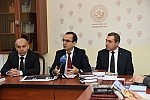 |
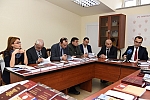 |
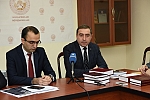 |
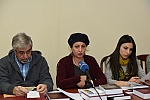 |
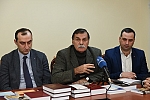 |
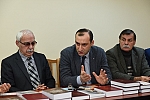 |
The press-conference summarizing the activities of the Institute for Armenian Studies took place in Yerevan State University on December 21, 2016. Speaking about the activities of the Institute during the last 7 years, Deputy Director of IAS, Candidate in Historical Sciences, Mher Hovhannisyan presented the research and publishing activities conducted by the various branches of the Institute, as well as its future plans. “During this time we managed to carry out fairly extensive research and scientific work, especially in the field of applied Armenology. In 2016 we have the honor to present 9 research works; 4 works are still in the publishing process”,- said M. Hovhannisyan.
Researcher of the Department of Armenian-Kurdish relations, specialist in Arabian Studies, Sargis Grigoryan presented his monograph entitled, “Islamic State From Roots to the Proclamation of Caliphate”.
“I am honored to present my own work alongside with such authors. I think that the topic is quite actual. We know that every day we face such tragic events, as terrorist attacks, murders, acts of violence, that are carried out by today’s most dangerous extremist radical organization, "Islamic State". I must note that the Syrian conflict has become the cause for new developments and new realities, one of which is the formation of Islamic State. This was the main reason that urged me to investigate Islamic State, its origins and leaders who founded it. I've also investigated the trends and characteristics that have made this organization what it is today”, - noted S. Grigoryan.
According to S. Grigoryan, Islamic State has become a global phenomenon, which is known by everyone. The author also presented his vision in the book on finding effective ways to fight against Islamic State.
Head of the Department of the Armenian-Kurdish relations Vahram Petrosyan spoke about his visit to Iraqi Kurdistan. V. Petrosyan noted that one of the main directions of IAS is also political Armenology, and the department plans to publish a new book about the Armenian-Kurdish relations, in which various issues related to Kurdish Studies will be observed. He presented the research work carried out in November, during the visit to Iraqi Kurdistan, spoke about the agreements reached during meetings with various Kurdish parties, as well as the joint work to be done in the future.
Head of the Department of Armenian-Ottoman Relations, Lusine Sahakyan presented the activities of the department and future projects. “During the last 3 years the department has been working on the preparation of the Ottoman language textbook, and it’s not an exaggeration, but this is the first textbook in the Armenian reality after 100 years. It’s a unique book and includes important grammar sections that consist of 32 lessons, Ottoman-Armenian dictionary and appendix of Ottoman texts. The textbook will give an opportunity to ensure an initial level of knowledge of the Ottoman language, which will contribute to the preparation of specialists in Ottoman Studies and manuscripts", - noted L. Sahakyan.
She also stressed the importance of field works carried out in Islamized Hamshen settlements in the provinces of Rize, Ardvin, Erzrum and added that a monograph about the Hamshen Armenians manuscripts will be published in the near future.
Head of Department of the Armenian-Georgian Relations, Hrachik Bayramyan and head of the Laboratory of Archaeological Research, Hayk Avetisyan also spoke about their future projects. Avetisyan presented the work on the khachkars culture carried out by the Laboratory in Kotayk and Aragatsotn regions. He also spoke about the scientific and practical research and excavations carried out Western Armenia.
At the end of the discussion, the journalists addressed their questions to the speakers and an active discussion took place between those presents and speakers.